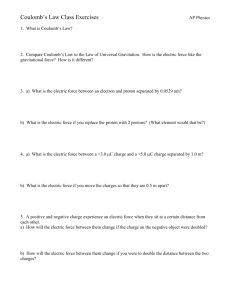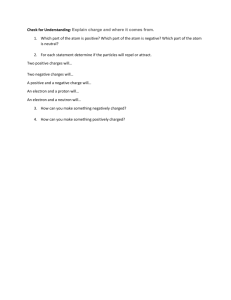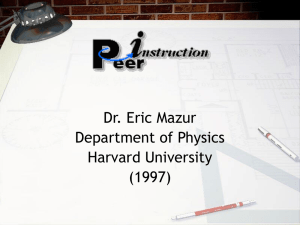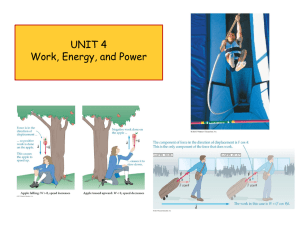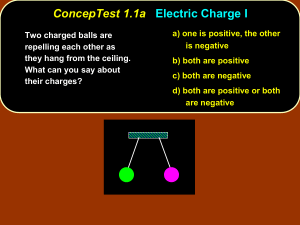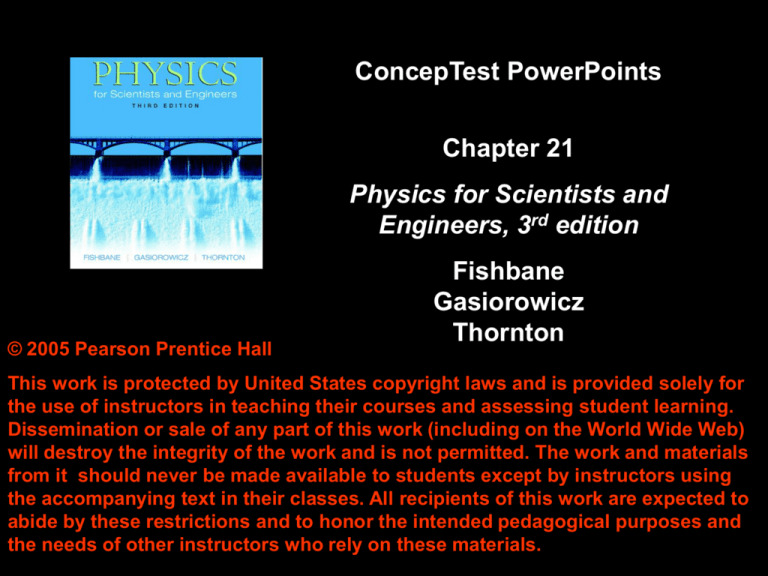
ConcepTest PowerPoints
Chapter 21
Physics for Scientists and
Engineers, 3rd edition
© 2005 Pearson Prentice Hall
Fishbane
Gasiorowicz
Thornton
This work is protected by United States copyright laws and is provided solely for
the use of instructors in teaching their courses and assessing student learning.
Dissemination or sale of any part of this work (including on the World Wide Web)
will destroy the integrity of the work and is not permitted. The work and materials
from it should never be made available to students except by instructors using
the accompanying text in their classes. All recipients of this work are expected to
abide by these restrictions and to honor the intended pedagogical purposes and
the needs of other instructors who rely on these materials.
ConcepTest 21.1a Electric Charge I
Two charged balls are
repelling each other as
they hang from the ceiling.
What can you say about
their charges?
1) one is positive, the other
is negative
2) both are positive
3) both are negative
4) both are positive or both
are negative
ConcepTest 21.1a Electric Charge I
Two charged balls are
repelling each other as
they hang from the ceiling.
What can you say about
their charges?
1) one is positive, the other
is negative
2) both are positive
3) both are negative
4) both are positive or both
are negative
The fact that the balls repel each
other only can tell you that they
have the same charge, but you do
not know the sign. So they can
be either both positive or both
negative.
Follow-up: What does the picture look like if the two balls are oppositely
charged? What about if both balls are neutral?
ConcepTest 21.1b Electric Charge II
From the picture,
what can you
conclude about
the charges?
1)
have opposite charges
2)
have the same charge
3)
all have the same charge
4) one ball must be neutral (no charge)
ConcepTest 21.1b Electric Charge II
From the picture,
what can you
conclude about
the charges?
1)
have opposite charges
2)
have the same charge
3)
all have the same charge
4) one ball must be neutral (no charge)
The GREEN and PINK balls must
have the same charge, since they
repel each other. The YELLOW
ball also repels the GREEN, so it
must also have the same charge
as the GREEN (and the PINK).
ConcepTest 21.2a Conductors I
A metal ball hangs from the ceiling
1) positive
by an insulating thread. The ball is
2) negative
attracted to a positive-charged rod
3) neutral
held near the ball. The charge of
4) positive or neutral
the ball must be:
5) negative or neutral
ConcepTest 21.2a Conductors I
A metal ball hangs from the ceiling
1) positive
by an insulating thread. The ball is
2) negative
attracted to a positive-charged rod
3) neutral
held near the ball. The charge of
4) positive or neutral
the ball must be:
5) negative or neutral
Clearly, the ball will be attracted if its
charge is negative. However, even if
the ball is neutral, the charges in the
ball can be separated by induction
(polarization), leading to a net
attraction.
remember
the ball is a
conductor!
Follow-up: What happens if the metal ball is replaced by a plastic ball?
ConcepTest 21.2b Conductors II
Two neutral conductors are connected
1)
0
0
by a wire and a charged rod is brought
2)
+
–
3)
–
+
4)
+
+
5)
–
–
near, but does not touch. The wire is
taken away, and then the charged rod
is removed. What are the charges on
the conductors?
0
0
?
?
ConcepTest 21.2b Conductors II
Two neutral conductors are connected
1)
0
0
by a wire and a charged rod is brought
2)
+
–
3)
–
+
4)
+
+
5)
–
–
near, but does not touch. The wire is
taken away, and then the charged rod
is removed. What are the charges on
the conductors?
While the conductors are connected, positive
0
0
?
?
charge will flow from the blue to the green
ball due to polarization. Once disconnected,
the charges will remain on the separate
conductors even when the rod is removed.
Follow-up: What will happen when the
conductors are reconnected with a wire?
ConcepTest 21.3a Coulomb’s Law I
What is the magnitude
1) 1.0 N
2) 1.5 N
of the force F2?
3) 2.0 N
F1 = 3N
Q
Q
F2 = ?
4) 3.0 N
5) 6.0 N
ConcepTest 21.3a Coulomb’s Law I
What is the magnitude
1) 1.0 N
2) 1.5 N
of the force F2?
3) 2.0 N
F1 = 3N
Q
Q
F2 = ?
4) 3.0 N
5) 6.0 N
The force F2 must have the same magnitude as F1. This is
due to the fact that the form of Coulomb’s Law is totally
symmetric with respect to the two charges involved. The
force of one on the other of a pair is the same as the reverse.
Note that this sounds suspiciously like Newton’s 3rd Law!!
ConcepTest 21.3b Coulomb’s Law II
F1 = 3N
Q
Q
F2 = ?
2) 3.0 N
If we increase one charge to 4Q,
what is the magnitude of F1?
F1 = ?
4Q
Q
1) 3/4 N
F2 = ?
3) 12 N
4) 16 N
5) 48 N
ConcepTest 21.3b Coulomb’s Law II
F1 = 3N
Q
Q
F2 = ?
2) 3.0 N
If we increase one charge to 4Q,
what is the magnitude of F1?
F1 = ?
4Q
Q
1) 3/4 N
F2 = ?
3) 12 N
4) 16 N
5) 48 N
Originally we had:
F1 = k(Q)(Q)/r2 = 3 N
Now we have:
F1 = k(4Q)(Q)/r2
which is 4 times bigger than before.
Follow-up: Now what is the magnitude of F2?
ConcepTest 21.3c Coulomb’s Law III
The force between two charges
1) 9 F
separated by a distance d is F. If
2) 3 F
the charges are pulled apart to a
3) F
distance 3d, what is the force on
4) 1/3 F
each charge?
5) 1/9 F
F
F
Q
Q
d
?
?
Q
Q
3d
ConcepTest 21.3c Coulomb’s Law III
The force between two charges
1) 9 F
separated by a distance d is F. If
2) 3 F
the charges are pulled apart to a
3) F
distance 3d, what is the force on
4) 1/3 F
each charge?
5) 1/9 F
F
Originally we had:
F
Q
Q
Fbefore = k(Q)(Q)/d2 = F
Now we have:
Fafter = k(Q)(Q)/(3d)2 = 1/9 F
d
?
?
Q
Q
3d
Follow-up: What is the force if the original distance is halved?
ConcepTest 21.4a Electric Force I
Two balls with charges +Q and +4Q
are fixed at a separation distance of
3R. Is it possible to place another
charged ball Q0 on the line between
the two charges such that the net
force on Q0 will be zero?
1) yes, but only if Q0 is positive
2) yes, but only if Q0 is negative
3) yes, independent of the sign
(or value) of Q0
4) no, the net force can never
be zero
+4Q
+Q
3R
ConcepTest 21.4a Electric Force I
Two balls with charges +Q and +4Q
are fixed at a separation distance of
3R. Is it possible to place another
charged ball Q0 on the line between
the two charges such that the net
force on Q0 will be zero?
1) yes, but only if Q0 is positive
2) yes, but only if Q0 is negative
3) yes, independent of the sign
(or value) of Q0
4) no, the net force can never
be zero
A positive charge would be repelled
by both charges, so a point where
these two repulsive forces cancel
+4Q
+Q
can be found. A negative charge
would be attracted by both, and the
same argument holds.
Follow-up: What happens if both charges are +Q?
Where would the F = 0 point be in this case?
3R
ConcepTest 21.4b Electric Force II
Two balls with charges +Q and +4Q are separated by 3R. Where
should you place another charged ball Q0 on the line between
the two charges such that the net force on Q0 will be zero?
+4Q
+Q
1
2
3
4
2R
R
3R
5
ConcepTest 21.4b Electric Force II
Two balls with charges +Q and +4Q are separated by 3R. Where
should you place another charged ball Q0 on the line between
the two charges such that the net force on Q0 will be zero?
+4Q
+Q
1
2
3
4
5
2R
R
3R
The force on Q0 due to +Q is:
F = k(Q0)(Q)/R2
The force on Q0 due to +4Q is:
F = k(Q0)(4Q)/(2R)2
Since +4Q is 4 times bigger than +Q, then Q0 needs to be
farther from +4Q. In fact, Q0 must be twice as far from +4Q,
since the distance is squared in Coulomb’s Law.
ConcepTest 21.4c Electric Force III
Two balls with charges +Q and –4Q
are fixed at a separation distance of
3R. Is it possible to place another
charged ball Q0 anywhere on the
line such that the net force on Q0
will be zero?
1) yes, but only if Q0 is positive
2) yes, but only if Q0 is negative
3) yes, independent of the sign
(or value) of Q0
4) no, the net force can never
be zero
– 4Q
+Q
3R
ConcepTest 21.4c Electric Force III
Two balls with charges +Q and –4Q
are fixed at a separation distance of
3R. Is it possible to place another
charged ball Q0 anywhere on the
line such that the net force on Q0
will be zero?
1) yes, but only if Q0 is positive
2) yes, but only if Q0 is negative
3) yes, independent of the sign
(or value) of Q0
4) no, the net force can never
be zero
A charge (positive or negative) can be
placed to the left of the +Q charge,
– 4Q
+Q
such that the repulsive force from the
+Q charge cancels the attractive
3R
force from –4Q.
Follow-up: What happens if one charge is +Q and the other is –Q?
ConcepTest 21.5a Proton and Electron I
A proton and an electron are
held apart a distance of 1 m
and then released. As they
approach each other, what
happens to the force between
them?
p
1) it gets bigger
2) it gets smaller
3) it stays the same
e
ConcepTest 21.5a Proton and Electron I
A proton and an electron are
held apart a distance of 1 m
and then released. As they
approach each other, what
happens to the force between
them?
1) it gets bigger
2) it gets smaller
3) it stays the same
By Coulomb’s Law, the force between the
two charges is inversely proportional to
the distance squared. So, the closer they
get to each other, the bigger the electric
force between them gets!
p
e
Q1Q 2
Fk
r2
Follow-up: Which particle feels the larger force at any one moment?
ConcepTest 21.5b Proton and Electron II
A proton and an electron are held
1) proton
apart a distance of 1 m and then
2) electron
released. Which particle has the
3) both the same
larger acceleration at any one
moment?
p
e
ConcepTest 21.5b Proton and Electron II
A proton and an electron are held
1) proton
apart a distance of 1 m and then
2) electron
released. Which particle has the
3) both the same
larger acceleration at any one
moment?
p
The two particles feel the same force.
Since F = ma, the particle with the smaller
mass will have the larger acceleration.
This would be the electron.
e
Q1Q 2
Fk
r2
ConcepTest 21.5c Proton and Electron III
A proton and an electron
are held apart a distance
of 1 m and then let go.
Where would they meet?
1) in the middle
2) closer to the electron’s side
3) closer to the proton’s side
p
e
ConcepTest 21.5c Proton and Electron III
A proton and an electron
are held apart a distance
of 1 m and then let go.
Where would they meet?
1) in the middle
2) closer to the electron’s side
3) closer to the proton’s side
By Newton’s 3rd Law, the electron and proton
feel the same force. But, since F = ma, and
since the proton’s mass is much greater, the
proton’s acceleration will be much smaller!
p
Thus, they will meet closer to the proton’s
original position.
Follow-up: Which particle will be moving faster when they meet?
e
1
ConcepTest 21.6 Forces in 2D
2
3
Which of the arrows best
4
represents the direction
of the net force on charge
d
+2Q
+Q
+Q due to the other two
charges?
d
+4Q
5
1
ConcepTest 21.6 Forces in 2D
2
3
Which of the arrows best
4
represents the direction
of the net force on charge
d
+2Q
+Q
+Q due to the other two
d
charges?
+4Q
The charge +2Q repels +Q towards
the right. The charge +4Q repels +Q
upwards, but with a stronger force.
Therefore, the net force is up and to
+2Q
the right, but mostly up.
Follow-up: What happens if the
yellow charge would be +3Q?
+4Q
5



